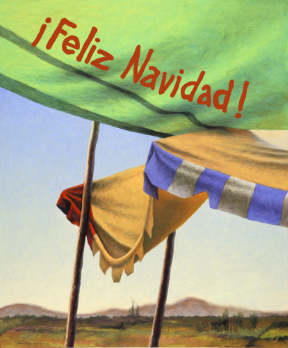
We dedicate today's concert to the people of Ukraine for their incredible courage, tenacity, and brilliant creativity in the face of unspeakable horrors, and for their fierce determination to fight for their people and their beloved homeland.
“Prayer for Ukraine’’
Composed by Mikola Lysenko
Lyrics by Oleksandr Konysky
Instrumental Ensemble:
Kay Reilly, marimba, percussion
Jamie Ihler, percussion
Eli Schille-Hudson, guitar
Thomas Mayes, bass
Dongho Lee, piano
“Carol of the Bells’’
Mykola Leontovich (1877–1921)
Arr. Peter Wilhousky
“Ríu, Ríu, Chíu’’
Spanish carol, arr. Russell Robinson
Soloists:
Sara Negishi, soprano
Kasey Potzler, alto
John Tilley, bass
THREE VENEZUELAN CHRISTMAS CAROLS
Arr. Bruce Trinkley
“La Jornada’’
Soloists:
Jessica Rodriguez, soprano
Joanna Wiebe, alto
“Como Busca el Tierno ’’
NAVIDAD NUESTRA
Ariel Ramirez (1921–2010)
Soloists:
Connor Bennion, tenor I
Eric Morgan, tenor II
Norman Hale, baritone
“La Anunciación’’
“La Peregrinacíon’’
“El Nacimiento’’
“Los Pastores’’
“Los Reyes Magos’’
“La Huida’’
INTERMISSION
“The Last One to Bethlehem’’
Larry Shackley (1956–)
“Shepherds' Dance’’
Scott Henderson (1956–)
Martin Bray, flute
MISA CRIOLLA
Ariel Ramírez (1921–2010)
Soloists:
Connor Bennion, tenor I
Eric Morgan, tenor II
Norman Hale, baritone
Kyrie
Gloria
Credo
Sanctus
Agnus Dei
“¡Fum, Fum, Fum!’’
Conrad Susa (1935–2013)
¡Feliz Navidad! Wishing you a joyous holiday season!
This afternoon Whatcom Chorale celebrates Feliz Navidad with profound expressions of faith drawn largely from Hispanic traditions. The music speaks to people on an intimate level, using common images from everyday life to evoke universal emotions. The exuberance of percussive instruments supports soaring and frequently exposed vocal lines that emphatically proclaim the tenets of belief. We are fortunate to be joined by a talented group of musicians playing authentic instruments.
The familiar Christmas standard “Carol of the Bells,” composed in 1916 by Mykola Leontovich (1877–1921), was based on a Ukrainian folksong that celebrated the coming of spring rather than the Christ child. The song’s original lyrics told of a swallow optimistically heralding the master of the house with predictions of wealth, healthy livestock, and a beautiful wife. Traditionally, young girls in Ukraine paraded from house to house singing this tune to celebrate the New Year and wish their neighbors good fortune. Baked goods and treats rewarded those who serenaded their fellow villagers from the chilly streets. Leontovich called his revision of the folksong, “Shchedryk,” (“bountiful”). It was widely performed by the Ukrainian National Chorus in Europe and North and South America, including a sold-out performance at Carnegie Hall in 1921. When American choir director and arranger Peter Wilhousky heard the work, its driving four-note melody reminded him of bells. Thus he rewrote the lyrics to convey the insistent imagery of chiming church bells joyously proclaiming the Christmas season. In 1936 Wilhousky copyrighted his new lyrics and published the song as “Carol of the Bells,” despite the fact that the music had been published and performed in Ukraine nearly two decades earlier. Not surprisingly, Wilhousky’s choral arrangement gained immense popularity, with its emphatic treble melody punctuated by the ding-dong ding-dong counter motif in the lower voices. Later versions have spanned genres from pop to jazz to soul. Today Whatcom Chorale remembers with hope the origin of “Shchedryk,” and we fervently wish the people of Ukraine prosperity, peace, and the coming of a bountiful new spring.
“Ríu, Ríu, Chíu,” arranged by Russell Robinson, is a Spanish carol dating from the Renaissance period, approximately 1550. The title and refrain, “Ríu, ríu, chíu” (meaning “river, roaring river”), was a traditional call Spanish shepherds used when guarding their flocks. The text delivers its adamant message as a metaphor drawn from a pastoral setting in which the shepherd (God) guards the lamb (the Christ child) from the black wolf (Satan). God protects the lowly, the defenseless, and the innocent from harm, bestowing a promise of hope and joy that embodies the potential for peace. The repetitive and fiercely energetic melody leaves little doubt that God will overcome the specter of death with endless joy.
Three Venezuelan Christmas Carols, arranged by Bruce Trinkley, continues the theme of shared human needs and desires. The halting, jerky rhythms of “La Jornada” aptly convey the slow, plodding progress of Mary and Joseph toward Bethlehem and Mary’s growing discomfort as the couple seeks shelter from the advancing cold and dark. “Como Busca El Tierno Infante” describes the newly born baby Jesus, frightened, hungry, and cold, suckling at his mother’s breast. The lullaby’s haunting melody and tender image of mother and child lead to a personal reflection that the holy Mother offers comfort to all. The third carol, “Cantemos,” is a joyful homage to the Christ child that invests all hope of salvation with the newborn babe. Its deceptively simple melody reinforces the paradox that to commit one’s faith to the child is to accept one’s own vulnerability.
Argentine composer Ariel Ramírez (1921–2010) made a lifelong study of the folklore and traditions of Hispanic America. Travels among the native Guarani in the remote northeast, the gauchos in the pampas, and the Criollo in the Andean northwest inspired Ramírez to embrace the songs and rhythms that characterize each region of his homeland. From his passion for the expressive arts of these peoples and others, Ramírez created Navidad Nuestra, a native tableau in which the miracle of the Incarnation is related via words and melodies evoking the vivid spirit of the Hispanic American land. Each movement tells a part of the nativity story with a distinctive regional dance. Details, such as the wise men’s gifts of honey, jelly, and an alpaca poncho, are comfortably practical and familiar rather than exotic. The verses, written by Felix Luna, are tender and simple, an unabashed portrayal of devotion and joy at Christ’s birth.
“The Last One to Bethlehem,” composed by Larry Shackley, is a touching narrative of a village boy, Pepito, who like many of us during this season is always running behind. Predictably, he is the last of his friends to arrive at the manger scene. But as Pepito beholds the miracle of the newborn baby Jesus, he inadvertently steps forward, propelled by wonder and awe. Mary recognizes his sincerity of heart and offers him the child to hold. Pepito is perhaps not the fastest or the strongest, the smartest or even the bravest, but his emotions are pure and his unhesitating faith reaps a great reward. Shackley engages the listener by cleverly using rhythmic variation to imitate Pepito’s foibles. In the final stanzas, however, the simple melody broadens with lush harmonies to show how the humble contains the potential to become exalted.
It isn’t often that Chorale has the opportunity to rehearse and receive direct input from a composer; thus we are delighted to offer Scott Henderson’s “Shepherds’ Dance” as part of today’s program. When asked to provide a few insights, Henderson responded, “I usually compose for a specific ensemble or concert, but ‘Shepherds’ Dance’ was one piece I wrote just for the fun of it. Browsing the internet for Christmas poems back in 2003, I fell in love with this old Austrian text, translated into English in the nineteenth century. There was something very energetic and contemporary in the imagery of shepherds called to the Nativity and exhorting villagers into a joyful dance. I wrote the music over a couple of weeks and it promptly went into a drawer. I want to thank Deb (Brown) and my friends in Chorale for giving voice to my piece.” Chorale is thrilled to reprise this artful dance and share its infectious exuberance.
Proving that brilliance can arise from extreme darkness, Ariel Ramírez attributes the writing of Misa Criolla to his post-Holocaust visit to Germany. “I felt I had to compose something deep and religious that would revere life and involve people beyond their creeds, race, color, or origin. The song is a tribute to human dignity, courage, and freedom, with a distinct message of Christian love.” Also essential to the creation of Misa Criolla was the Second Vatican Council (1962–65), which permitted the Catholic Mass to be celebrated in local languages familiar to the people rather than Latin. This fundamental revision enacted the Church’s commitment to making the liturgy more meaningful to faithful worshippers worldwide. Ramírez’s Mass won critical acclaim as a “stunning artistic achievement” combining Spanish text with indigenous instruments and rhythms to create the effect of a “reverent carnival.” Album sales reached the millions on multiple recordings that featured José Carreras, Mercedes Sosa, and Plácido Domingo. As in Navidad Nuestra, Ramírez employs regional folk cadences to depict emotions ranging from the loneliness of the high plateau to the rejoicing of a carnival celebration to the frenzied declaration of belief. Both the poignancy and the popularity of Ramírez's work emanate from the simple melodies and driving rhythms familiar to the native peoples of Hispanic America.
Conrad Susa (1935–2013) drew inspiration from a sixteenth-century Catalan carol to compose the boisterous “Fum, Fum, Fum.” He intended the piece as an encore for his innovative work Carols and Lullabies: Christmas in the Southwest, and it surely delivers a rousing finale. “Fum” translates to “smoke” in Catalan, and the verses that follow refer to the cold night and the Christ child’s need for warmth and light. It has been suggested that the refrain, “fum, fum, fum,” mimics one blowing on a fire to intensify the flame. It may also be an onomatopoetic reference to the strumming of a guitar, the beating of a drum, or the rocking of a cradle. No matter the literal meaning, the imperative lyrics and insistent rhythms of the song deliver a command. A new and miraculous life has entered the world, which must not be ignored. Each of us has something to offer, whether it be warmth, praise, music, comfort, or light. The carol entreats us to engage, to kindle the fire. And the world is forever altered as we answer the call, allowing this fragile babe to enlighten our hearts.
At its core, the music of today’s concert attests to an utter certainty of God’s providence as revealed through the beauty inherent in the harshest landscapes as well as the most bountiful. Every birth, after all, is a miracle, and the essence of life is joy. We heartily thank you for sharing in Whatcom Chorale’s gift of the season.



